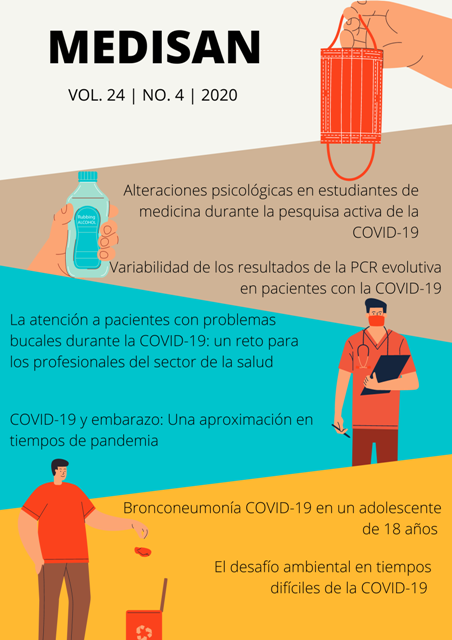Effectiveness of magnetotherapy in patients with temporomandibular joint disorders
Keywords:
temporomandibular joint, magnetotherapy, therapeutic effectiveness, temporomandibular joint disorder.Abstract
Introduction: The temporomandibular disorders constitute a group of musculo skeletal conditions that affect the temporomandibular joint, the mastication muscles and the adjacent anatomical structures.
Objective: To evaluate the effectiveness of the magnetotherapy in patients with temporomandibular joint disorders.
Method: A therapeutic intervention was carried out in Martires del Moncada Teaching Provincial Stomatologic Clinic in Santiago de Cuba, from June, 2016 to February, 2019. The sample was constituted by 132 patients distributed in 2 groups: A (study) and B (control) who received treatments with magneto (N=66) and conventional, respectively. Some variables were analyzed, such as sex, age, degree of the temporomandibular joint disorder and therapeutic effectiveness. The percentage as summary measure and the chi-square test with a significance level of 0.05 was used.
Results: There was a prevalence of the female sex (69.7 %) and the 40 - 49 age group (51.5 %). When concluding the treatment it was observed that in group A the response was effective in more than 90.0 % of the patients; however, in group B it was achieved just in a little more than 70.0 %.
Conclusions: The magnetotherapy was effective in patients with temporomandibular joint disorders.
Downloads
References
2. Nieto MJ, Del Castillo JL, Burgueño M, Alonso E, Guiñales J, Moreiras A. Derivación de pacientes con síndrome de disfunción temporomandibular desde Atención Primaria. Rev Esp Cir Oral Maxilofac. 2018 [citado 20/01/2019]; 40(3): 112-9. Disponible en: https://doi.org/10.1016/j.maxilo.2017.03.003
3. Castañeda Deroncelé M, Ramón Jiménez R. Uso de férulas oclusales en pacientes con trastornos temporomandibulares. MEDISAN. 2016; 20 (4) [citado 03/01/2019]. Disponible en: http://scielo.sld.cu/scielo.php?script=sci_arttext&pid=S1029-30192016000400014
4. Sharif M, Hussain S, Amjad A, Uzair Riaz M. Prevalence of different types of temporomandibular disorders seen at Armed Forces Institute of Dentistry. Pak Oral Dental J. 2018 [citado 20/01/2019]; 38 (1): 137-53. Disponible en: https://www.podj.com.pk/index.php/podj/article/view/153/137
5. Arant Martins PF, Stechman Neto J, Mendes Marques J, Kieski Martins S, Evandro Cristoff K, Santos Sampaio R, et al. Tinnitus and temporomandibular disorders: the knowledge of professionals for primary health care in the city of Curitiba. Int Tinnitus J. 2016 [citado 20/12/ 2018] 20 (1): 18-23. Disponible en: http://www.tinnitusjournal.com/articles/tinnitus-and-temporomandibular-disorders-the-knowledge-of-professionals-for-primary-health-care-in-the-city-of-curitiba.html
6. Santos Vergara P, Bustos Navarrete C, Flores Flores H. Efectividad de la terapia manual ortopédica incluida en un programa convencional en pacientes con desplazamiento discal sin reducción con limitación de apertura de la articulación temporomandibular en Concepción-Chile: Resultados preliminares. REEM. 2017 [citado 20/01/2019]; 3 (2): 17-24. Disponible en: http://www.reem.cl/descargas/reem_v3n2_a3.pdf
7. Cortese S, Mondello A, Galarza R, Biondi A. Postural alterations as a risk factor for temporomandibular disorders. Acta odontol latinoam. 2017 [citado 24/01/2019]; 30 (2): 57-61. Disponible en: http://www.scielo.org.ar/scielo.php?script=sci_arttext&pid=S1852-48342017000200002&lng=es&nrm=iso
8. Marroquín Soto C. Factores asociados a trastornos temporomandibulares en pacientes del servicio de estomatología quirúrgica del Hospital Nacional Arzobispo Loayza. [tesis]. Lima: Universidad Nacional Mayor de San Marcos; 2016 [citado 25/01/2019]. Disponible en: http://repositorio.usmp.edu.pe/bitstream/handle/usmp/2179/marroquin_sc.pdf?sequence=1&isAllowed=y
9. González Olivares H, López Saucedo F, Pérez Nova A. Prevalencia de disfunción de la articulación temporomandibular en médicos residentes del Hospital de Especialidades Centro Médico Nacional “La Raza”. Rev Odont Mex. 2016 [citado 25/01/2019]; 20 (1): 8-12. Disponible en: http://www.scielo.org.mx/scielo.php?script=sci_arttext&pid=S1870-199X2016000100008&lng=es&nrm=iso&tlng=es
10. Ariji Y, Ariji E. Resonancia magnética e imágenes ecográficas de mialgia muscular masticatoria en pacientes con trastorno temporomandibular. Revisión de la Ciencia Dental Japonesa. 2017; 53 (1): 11-7.
11. González Garcia X, Cardentey Garcia J, Porras Mijants O, Artidiello Bustio D. Efectividad de la magnetoterapia en el tratamiento de las afecciones dolorosas de la articulación temporomandibular. Revista Electrónica Dr. Zoilo E. Marinello Vidaurreta. 2016 [citado 20/12/2018]; 41 (7). Disponible en: http://revzoilomarinello.sld.cu/index.php/zmv/article/view/721
12. Matos Frómeta K, Guerra Santana A, Piña Odio I, Iglesias Díaz RD, Lujan Alfaro I. Ventajas de la ultrasonoterapia en pacientes con disfunción de la articulación temporomandibular. MEDISAN. 2012 [citado 07/06/2017]; 16 (5). Disponible en: http://bvs.sld.cu/revistas/san/vol_16_5_12/san02512.htm
13. Do Patrocínio Doval RT, Moura dos Santos AC, Silva da Penha E, Santos Carneiro Almeida M, Tenôrio Guênes GM, Machado da Costa Figueiredo CH. Disfunción temporomandibular y ansiedad en los estudiantes de Odontología. Rev Cubana Estomatol. 2019; 56 (1) [citado 03/01/2019]. Disponible en: http://www.revestomatologia.sld.cu/index.php/est/article/view/1796
14. Saez Carriera R, Velasco Cornejo K, Concha Urgilés G. Magnetoterapia como tratamiento en las disfunciones temporomandibulares. I Congreso Internacional de Investigación y Producción Científica en el campo de la Estomatología. Guayaquil: Universidad de Guayaquil; 2017.
15. Huber L, López Vallejos MJ, Rosende Roque Ó. Ruidos articulares en pacientes rehabilitados con prótesis parcial removible. Rev Odont Mex. 2018; 22 (2): 88-94.
16. Quispe Paredes R. Prevalencia y grado de complejidad de trastornos temporomandibulares según Indice de Helkimo, en pacientes edéntulos parciales del Centro de Salud Chejoña-Puno, 2015. [tesis]. Puno: Universidad Nacional del Altiplano; 2016 [citado 25/01/2019]. Disponible en: http://repositorio.unap.edu.pe/bitstream/handle/UNAP/2691/Quispe_Paredes_Richard_pdf?sequence=1&%20is%20Allowed=y
17. Soto Cantero L, de la Torre Morales JD, Aguirre Espinosa I, de la Torre Rodríguez E. Trastornos temporomandibulares en pacientes con maloclusiones. Rev Cubana Estomatol. 2013; 50 (4) [citado 14/01/2019]. Disponible en: http://www.revestomatologia.sld.cu/index.php/est/article/view/229/43
18. Herrero Solano Y. Disfunción de la articulacióm temporomandibular en pacientes con anomalías dentomaxilofaciales. Rev Cubana Estomatol. 2019 [citado 14/05/2019]; 56 (1). Disponible en: http://www.revestomatologia.sld.cu/index.php/est/article/view/1924
19. Rodríguez Betancourt MC, Mursulí Sosa M, Díaz Batista R, Rodríguez Navia TC. Magnetoterapia en el dolor miofacial. Presentación de casos. Gac méd espirit. 2011; 13 (3) [citado 27/04/2020]. Disponible en: http://revgmespirituana.sld.cu/index.php/gme/article/view/363/328
.
Published
How to Cite
Issue
Section
License
All the articles can be downloaded or read for free. The journal does not charge any amount of money to the authors for the reception, edition or the publication of the articles, making the whole process completely free. Medisan has no embargo period and it is published under the license of Creative Commons, International Non Commercial Recognition 4.0, which authorizes the copy, reproduction and the total or partial distribution of the articles in any format or platform, with the conditions of citing the source of information and not to be used for profitable purposes.





